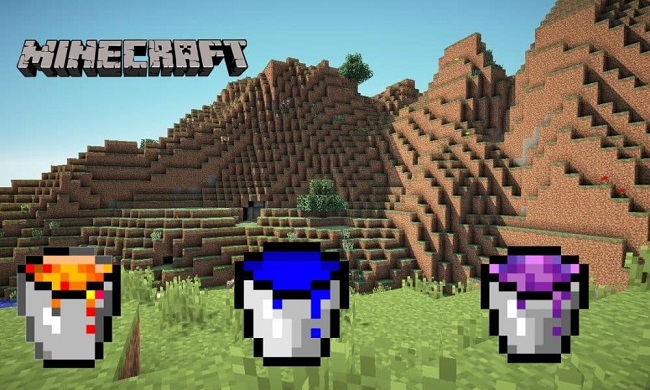Minecraft, the immensely popular sandbox game developed by Mojang Studios, offers players endless opportunities for creativity and exploration. One essential item in Minecraft is the bucket, which allows players to carry and transport liquids such as water, lava, and milk.
In this comprehensive, SEO-optimized article, we’ll provide a detailed guide on how to make a bucket in Minecraft, including the necessary materials, crafting recipe, and practical uses for this versatile tool, providing a detailed 1000-word exploration.

Introduction to Crafting in Minecraft: The Basics
Crafting is a fundamental aspect of gameplay in Minecraft, allowing players to create tools, weapons, and items from various materials found in the game world. By combining different resources in the crafting grid, players can craft a wide range of items to aid them in their adventures.
Read Also:
Understanding the Importance of Buckets
Buckets are essential tools in Minecraft, allowing players to collect and transport liquids such as water, lava, and milk. With a bucket in hand, players can manipulate the environment, create obsidian, extinguish fires, and even transport animals. Learning how to craft a bucket is a crucial skill for any Minecraft player.
Key Uses of Buckets
- Collecting Water: Buckets can be used to collect water from lakes, rivers, or even rain, which can then be transported and used for various purposes such as farming, irrigation, and crafting.
- Gathering Lava: Lava is a valuable resource in Minecraft, used for smelting ores, powering furnaces, and creating obsidian. Buckets allow players to collect and transport lava safely.
- Milking Cows: Buckets can be used to milk cows, providing players with a source of milk that can be used for crafting food items such as cake and pumpkin pie.
Making iron ingots
Iron ingots necessitate two primary ingredients. Iron ore and a heating device are the first two components. Iron ore blocks are mineable items that can be found in caves, mountains, and dungeons.
Once you have gathered enough iron ingots, you will need to throw them into a furnace with some sort of fuel. Iron ingots can then be smelted from here.
So, if you’re wondering where to find a furnace after reading this, you needn’t worry; they’re simple to construct. To make one, simply fill a crafting table with 8 cobblestones.
The cobblestone blocks are the ones in the image above that are encircled by the iron ore; they are mined in the same way as the iron ore, with a pickaxe.
The final ingredient is fuel, and wooden logs are one of the quickest and most reliable resources to amass. The wooden logs can be obtained by first locating a suitable location containing trees, and then either manually or mechanically felling those trees.
Next, set the furnace down on the ground by clicking on it, loading it up first with wooden logs and then with iron ore. The iron ingots-making smelting procedure is shown below.
How To Make a Bucket in Minecraft?
Using a crafting table, create a bucket out of three iron ingots.
A Bucket’s Worth of Advice
Just click on a water source while equipping it, and the bucket’s interior will change to a blue tint to indicate that it’s full.
These brimming containers come in handy when building farms out of materials like cobblestones. The primary use for a full bucket is moving its contents to a location without access to such supplies.
Crafting a Bucket: Step-by-Step Guide
Crafting a bucket in Minecraft is a relatively straightforward process that requires only a few simple materials. Follow these steps to craft a bucket:
Step 1: Gather Materials
To craft a bucket, you will need three iron ingots. Iron ingots can be obtained by smelting iron ore in a furnace. Iron ore is commonly found underground in caves and mineshafts and can be mined with a stone pickaxe or higher.
Step 2: Open the Crafting Table
Next, open the crafting table interface. You can do this by right-clicking on a crafting table that you have placed in the game world. If you do not have a crafting table, you can craft one by placing four wooden planks in a square pattern in the crafting grid.
Step 3: Arrange Materials
In the crafting table interface, arrange the three iron ingots in a “V” shape pattern. Place one iron ingot in the center slot of the top row, one iron ingot in the center slot of the middle row, and one iron ingot in the center slot of the bottom row.
Step 4: Retrieve the Bucket
Once you have arranged the iron ingots in the crafting grid, the bucket will appear in the result box to the right of the grid. Simply click on the bucket icon to retrieve it from the crafting table.
Congratulations! You have successfully crafted a bucket in Minecraft.
Practical Uses for Buckets
Now that you have crafted a bucket, you can use it for a variety of practical purposes in Minecraft. Here are some common uses for buckets:
1. Collecting Water
Use your bucket to collect water from nearby lakes, rivers, or even rain. Water can be used for farming, irrigation, extinguishing fires, and crafting various items such as potions and concrete.
2. Gathering Lava
Collect lava from underground lava pools or from the Nether using your bucket. Lava is a valuable resource for smelting ores, powering furnaces, and creating obsidian.
3. Milking Cows
If you come across a cow in your travels, use your bucket to milk it. Milk can be used for crafting food items such as cake and pumpkin pie, as well as for removing negative status effects such as poison.
Read Also:
Conclusion
The ability to hold liquids like water and lava in a bucket makes it a crucial tool in Minecraft. After that, you can add them to your inventory and take them with you everywhere you go. It is a crucial component in the production of several commodities, including wheat and cobblestones.


